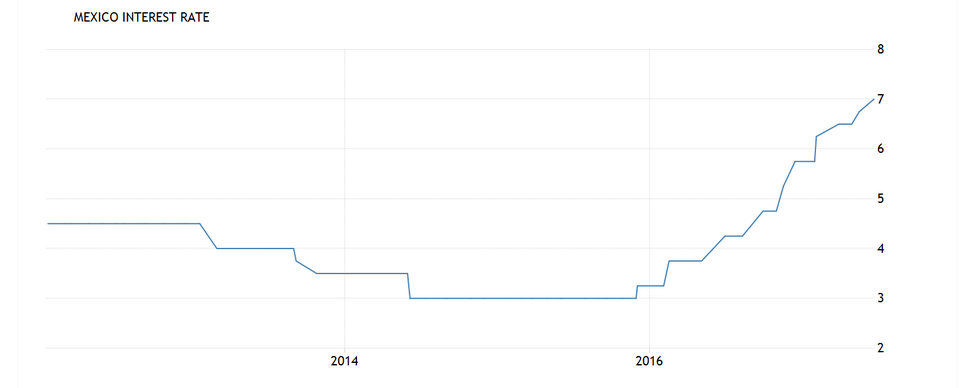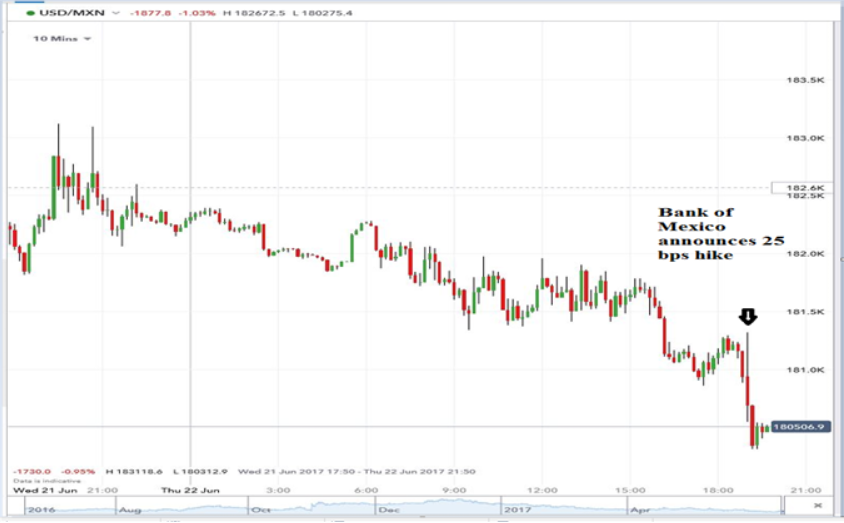Could the Pound Be Poised for a Turnaround Against the Peso?

Mexico shares many of the same currency challenges as England, only the way in which she has dealt with them has been radically different.
Both countries saw their currencies devalue rapidly following political events in 2016 – Sterling broke on Brexit trade fears and the Peso fell on Trump trade fears.
Both then suffered horrendous inflation due to their weak currencies, although in the case of Mexico the impact on inflation was worse than in the UK.
This was due to the Mexican government opting to remove extensive subsidies on gasoline prices which sent fuel prices soaring.
“A jump in fuel prices and a rapid decline by the currency following Donald Trump’s election have helped to push inflation well above the target range,” said Bloomberg.
Since reaching a trough against the Dollar at 22 pesos in January 2017, the Peso has undergone a quiet revolution and recovered to 18.
“Improving prospects for a positive outcome in NAFTA negotiations have made the peso a top performing currency since mid-January,” said Bloomberg.
One of the main driving forces behind the Peso’s rapid recovery lies in the reaction of the Bank of Mexico (BOM) which was very different to that of the Bank of England (BOE).
After then Peso devalued the BOM immediately started raising interest rates – sometimes in double quick 0.50% steps.
And sure enough the Peso rose due to the increase in capital inflows that the promise of higher interest rates attracts.
At the last meeting on June 22 (Thursday) the Banxico - as the BOM is known - increased interest rates once again, only this time by a more muted 0.25%, to a very high 7.0%.

The reaction of the Peso was immediate and unequivocal, it rose from 18.40 to 18.10 within minutes.

Meanwhile, the Bank of England (BOE) has not raised interest rates at all since the Pound plummeted after the referendum in the summer of 2016.
With calls growing in the Uk to raise interest rates, however, could it be we will see a lagged response by the BOE to the same problem facing the Banxico? trading opportunity?
And could the delay in the BOE increasing rates at a time where Banxico is considering leaving them present markets with a trading opportunity?
Mexican Growth Potential
We shall return to the subject of the Pound to Mexican Peso and the relative policies of Banxico and BOE.
First, we need to fully understand the drivers behind the Peso’s dramatic appreciation.
The currency has much going for it: the Mexican economy is growing strongly, and most economists interviewed by Bloomberg see it outstripping North American growth.
The recent elections reduced political risk by bringing back a stable government.
A primary driver for the currency, is demand from the carry trade, a form of investment in which traders borrow from a low interest rate currency jurisdiction and invest that money in higher interest rate jurisdiction, with a relatively stable economic and political backdrop.
Mexico is now a perfect target for the carry trade, as illustrated by the steep increase in actual carry flows in the chart below.

With interest rates at 7.0%, the return from someone investing in Mexico having borrowed in the UK where borrowing costs are 0.25%, would be a sizeable 6.75% (7.0 - 0.25%).
The Peso has also been appreciating versus GBP so the carry trader would profit from the currency appreciation.
“Perhaps most importantly, following a significant hiking cycle, MXN is now a high- yielding currency, and is an attractive carry play,” said Morgan Stanley (MS) who remain “constructive the Peso”.
MS forecast the USD/MXN pair falling to 17.50 as the Peso outperforms the Dollar, mainly on carry demand.
Yet there are those who see the Peso’s days as numbered.
“Mexico’s swap rate curve is pricing out more chances of a hikes by the country’s central bank in 2017, so it is unlikely the central bank would counter moves by the Fed,” said Bloomberg.
After the Banxico’s June 22 meeting, the governor of the Bank, Augustin Carstens, heavily suggested that the 0.25% hike the bank had made might well be the last – at least based on the data available.
He suggested the cycle of tightening was ending as it had fulfilled its objective of meeting the inflation shock which happened following the Trump devaluation of the Peso.
“Monetary policy dynamics are in line with a one-off inflation shock,” said Carstens.
Nevertheless, he also said he saw 17 Pesos to the Dollar as “not unreasonable” suggesting there might be more gains in store.
Conditions for Reversal Against the Pound?
The Peso has risen versus the Pound, reaching new 2017 highs recently at 22.95 following the Banxico rate rise, from all-time lows of 28.00 to the Pound in February 2016.
Yet if the Banxico is at the end of its rate hiking cycle, could this provide the breathing space for the Pound to make a recovery versus the Peso?
This seems especially true when considering the different monetary policy dynamics in the two countries.
In the UK, the BOE has stuck to its accommodative policies despite rising inflation from the weak Pound.
Last week, however, we say rising dissent from some of the members of the monetary policy committee, after 3 of the 8 voted for higher rates.
This was followed by Governor Carney’s Mansion house speech in which he argued wages remained too "anaemic" for a rate rise.
This week on Wednesday, however, the BOE’s chief economist Andy Haldane said that he thought rates should be higher, and Kirsten Forces reiterated her view that they should, at her leaving speech.
Further risks are growing that a continued fall in the price of Oil, one of Mexico's main exports could undermine the Peso.
With pressure increasing on the BOE to lift rates and contrastingly the Banxico taking its foot off the pedal, as well as a potential headwind from falling oil prices, is the time now ripe for investors to buy the Pound against the Peso?




